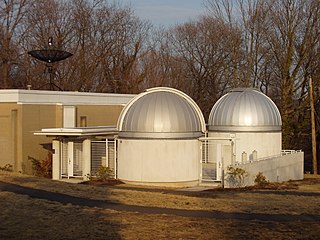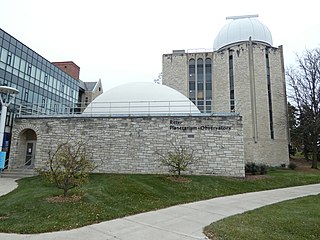
The Adler Planetarium is a public museum dedicated to the study of astronomy and astrophysics. It was founded in 1930 by Chicago business leader Max Adler. It is located on the northeast tip of Northerly Island at the shore of Lake Michigan in Chicago, Illinois. The Adler was the first planetarium in the United States and is part of Chicago's Museum Campus, which includes the John G. Shedd Aquarium and The Field Museum. The Adler's mission is to inspire exploration and understanding of the universe.

The Apache Point Observatory is an astronomical observatory located in the Sacramento Mountains in Sunspot, New Mexico, United States, approximately 18 miles (29 km) south of Cloudcroft. The observatory is operated by New Mexico State University (NMSU) and owned by the Astrophysical Research Consortium (ARC). Access to the telescopes and buildings is private and restricted.

Boyden Observatory is an astronomical research observatory and science education centre located in Maselspoort, 20 kilometres (12 mi) north-east of the city of Bloemfontein in Free State, South Africa. The observatory is managed by the Physics Department of the University of the Free State (UFS). The Friends of Boyden assist the observatory as a public support group, organising open evenings and protecting its public interest. Boyden also makes use of members of ASSA Bloemfontein Centre, the amateur astronomy club of the city, for presenters and telescope assistants.

Stardome Observatory is a public astronomical observatory situated in Cornwall Park in New Zealand's largest city, Auckland.

Armagh Observatory is an astronomical research institute in Armagh, Northern Ireland. Around 25 astronomers are based at the observatory, studying stellar astrophysics, the Sun, Solar System astronomy and Earth's climate.

Space Place at Carter Observatory is housed in a historic astronomical observatory located at the top of the Wellington Botanic Garden in Wellington, New Zealand.

South African Astronomical Observatory (SAAO) is the national centre for optical and infrared astronomy in South Africa. It was established in 1972. The observatory is run by the National Research Foundation of South Africa. The facility's function is to conduct research in astronomy and astrophysics. The primary telescopes are located in Sutherland, which is 370 kilometres (230 mi) from Observatory, Cape Town, where the headquarters is located.

The Goethe Link Observatory, observatory code 760, is an astronomical observatory near Brooklyn, Indiana, United States. It is owned by Indiana University and operated by the Indiana Astronomical Society, which efforts are dedicated to the pursuit of amateur astronomy.

Marseille Observatory is an astronomical observatory located in Marseille, France, with a history that goes back to the early 18th century. In its incarnation in 1877, it was the discovery site of a group of galaxies known as Stephan's Quintet, discovered by its director Édouard Stephan. Marseille Observatory is now run as a joint research unit by Aix-Marseille University and the French National Center for Scientific Research (CNRS).

Rainwater Observatory and Planetarium is an educational astronomical observatory and Planetarium run as an educational ministry of French Camp Academy. It is located near French Camp, Mississippi, United States. It is the largest observatory in Mississippi with 16+ telescopes, with the largest instruments including a 32-inch Dobsonian telescope and 14-inch Celestron catadioptric telescope. Rainwater is currently awaiting delivery of the Sollee Telescope, a 25-inch research-grade telescope. When installed in the two-story observatory building already constructed in the observatory complex, the Sollee Telescope will be suitable for serious astronomical studies, in the last remaining "dark spot" in Mississippi on the U.S. Dark Skies photograph.

UNA Observatory is an astronomical observatory owned and operated by the University of North Alabama. It is located in Florence, Alabama (USA). It has 2 telescopes, a Celestron 0.35 m Schmidt–Cassegrain telescope. The UNA Planetarium is a 65-seat planetarium with a Spitz A3P projector and East Cost Control Systems controller.

Maynard F. Jordan Observatory is an astronomical observatory owned and operated by University of Maine. Its first telescope was installed at the university in 1901, and was upgraded during the creation of the Emera Astronomy Center in 2014. It is located in Orono, Maine, USA. It is the only public observatory in the state of Maine. Operated by the department of Physics and Astronomy, the eight-inch Alvan Clark telescope is housed under a roll-off roof, next to the more modern PlaneWave CDK20 in its own dome.

Hopkins Observatory is an astronomical observatory owned and operated by Williams College in Williamstown, Massachusetts (USA). Constructed in 1838 by Albert Hopkins, the college claims that it is the oldest observatory in the United States.
Brooks Astronomical Observatory is an astronomical observatory owned and operated by Central Michigan University. It is located in Mount Pleasant, Michigan (USA). The observatory was established in 1964 and is located on the roof of the Brooks Hall science building. Both the building and observatory are named for Kendall P. Brooks, instructor of astronomy and other subjects in the period of 1910-1947.

The Yale University Observatory, also known as the Leitner Family Observatory and Planetarium, is an astronomical observatory owned and operated by Yale University, and maintained for student use. It is located in Farnham Memorial Gardens near the corner of Edwards and Prospect Streets, New Haven, Connecticut.

Holcomb Observatory and Planetarium is a part of Butler University in Indianapolis, Indiana.

Michigan State University Observatory is an astronomical observatory owned and operated by Michigan State University. It is located south of the Michigan State University campus in East Lansing, Michigan (USA), near the corner of Forest Rd and College Rd. It has a Cassegrain telescope in its single dome. Built by Boller and Chivens, the Michigan State University telescope was commissioned in 1969 and entered regular operation in 1970. In 1974, what was at the time a state-of-the-art Raytheon Microcomputer was installed to function as a data gathering and control system. Originally, single channel photoelectric photometry and photography using plates or film were the means of acquiring data. The observatory was closed from 1981 until 1986, at a time when the university was having financial difficulties. It was reopened in the spring of 1986 on the occasion of the return of Comet Halley and has been in regular operation ever since. Since the 1980s, a CCD camera has been employed as the main instrument and the Raytheon computer has been retired. The International Astronomical Union has assigned the MSU Observatory identification code 766.

The Norman Lockyer Observatory, the Lockyer Technology Centre, and the Planetarium, is a public access optical observatory 1 mile (1.6 km) east of Sidmouth, East Devon in South West England. It houses a number of historical optical telescopes, including the Lockyer Telescope, and is operated by Norman Lockyer Observatory Society (NLOS).

The Dearborn Observatory is an astronomical observatory located on the Evanston campus of Northwestern University. The observatory was originally constructed in 1888, though an agreement between the university and the Chicago Astronomical Society. In the summer of 1939, Dearborn Observatory had to be moved to make way for the construction of the Technological Institute.

The Ritter Observatory is an astronomical observatory owned and operated by the University of Toledo (UT) in Toledo, Ohio (USA). The Ritter Planetarium is located in the same building, and the university also operates Brooks Observatory in an adjacent building. Ritter Observatory features a 1.06 m (42 in) Ritchey-Chrétien telescope built in 1967 by Warner & Swasey Company of Cleveland, Ohio. It was installed in 1968, and is used primarily for spectroscopy and occasionally for instruction and public viewing events. Research conducted at the observatory focuses on long-term spectroscopic monitoring of stars such as Rigel, Beta Lyrae, and Zeta Tauri.

















